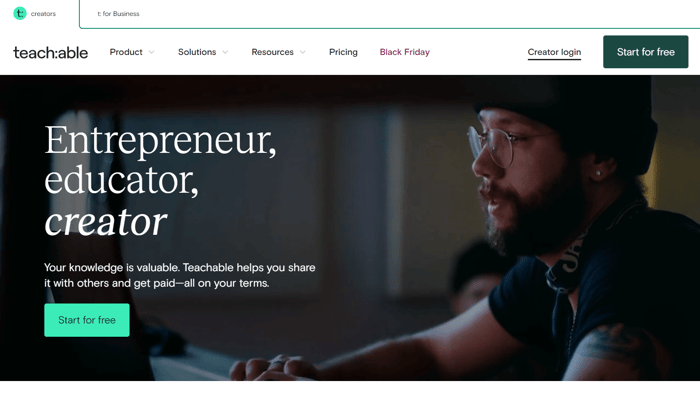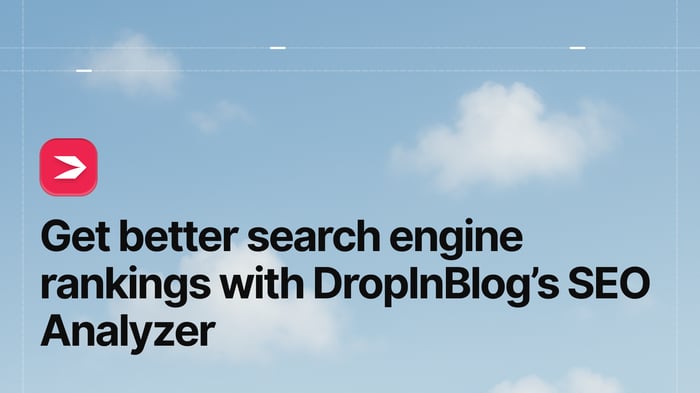Skillshare and Teachable are course hosting platforms that allow users to create and sell educational material. If you’re into online teaching and course creation, you can showcase your instructor skills and earn from your expertise on both platforms. However, as you'll see in this Skillshare vs. Teachable comparison, what each platform brings to the table differs significantly.

In a nutshell, Skillshare is much more like Udemy than Teachable. It’s an online platform where you sell your courses side by side with thousands of other users. What’s interesting is that on Skillshare, you can be both an instructor and a student at the same time.

Teachable is very different. This platform gives you the space to build a standalone online school. You don’t share the same space with other online instructors and educators – Teachable gives you the tools to build your own brand and reap the rewards.
In this Skillshare vs. Teachable comparison, we’ll talk about some of the key differences between these two platforms. The goal will be to present a clearer picture of how they work, what they offer, and what kind of education projects they are suitable for.
| A quick comparison: | ||
| Skillshare | Teachable | |
| Making a profit |
|
|
| Integrations |
|
|
| Audience |
|
|
| Classes |
|
|
| Costs |
|
|
Table of Contents
Making a Profit
Skillshare
Skillshare and Teachable differ a lot regarding how you profit from your educational material. Let’s take a closer look at Skillshare’s revenue system first.
Skillshare offers two possibilities to earn:
- Referrals
- Teacher fund
Skillshare gives you the ability to earn from referral links. When you become a teacher on Skillshare, you’ll receive your own referral link, which you can promote through whichever channels you choose. When a new student signs up using your referral link, you’ll get 60% of their first membership payment.
However, understanding how much membership costs is a bit of a challenge. Skillshare is notoriously tight-lipped about its membership prices. You are able to sign up for a free trial period of seven days, but you must submit payment details when you sign up.
If you don’t cancel before the end of the trial period, you’ll be charged a full annual subscription. Not only that, but Skillshare doesn’t tell you what an annual subscription costs until after you’ve signed up.
The Skillshare Teacher Fund
The Skillshare Teacher Fund is a unique concept. Students' membership fees essentially get pooled, and you, as the teacher, get paid from that pool of income. Payment is derived from the amount of engagement with your classes. For example, the number of minutes a student watched a course video and positive reviews from students.
Teachers selected for the Top Teacher and Teacher Corps programs are eligible for review-based bonuses. If teachers receive at least one positive review from a new student, they will automatically receive a bonus of $250 (Top Teacher) or $100 (Rising Teachers).
So, you can see that there is no fixed payment, and it’s difficult to gauge how much you’ll earn each month. Of course, more minutes viewed means more revenue, but the amount of money you earn every month will change depending on multiple variables.
Getting Paid on Skillshare
Another factor that has an impact on teacher earnings is how frequently you upload new classes. The newer the course, the greater the chances to earn more. If you want to keep making profits, you’ve got to create and upload new courses continuously.
When it comes to getting paid, Skillshare pays its teachers only via PayPal, wire transfer, prepaid debit cards, Intercash, and direct depost/e-check/AHC. If you’re in a country where PayPal doesn’t work, you can use other available payment methods. The pay date is fixed for the 16th of each month.
Considering the nature of the platform, Skillshare doesn’t give you the capacity to earn as much as you could on Teachable. So, let’s have a look at how Teachable compares in terms of earning structure and potential.
Teachable
As far as earning is concerned, Teachable is far more flexible. The platform gives you the freedom to earn as much as possible. You set your own prices and earn profit based on the number of sales you make. It all comes down to how successful you are in promoting your brand and how well you deliver on your customers’ expectations.
Teachable doesn’t put a cap on your course prices, like Udemy, or dictate prices in advance. Everything concerning your possible earnings is in your hands.
However, Teachable does include transaction fees, but only with lower-tier plans. The Free plan includes a $1 + 10% transaction fee on every purchase, while the Basic plan has a 5% transaction fee.
You’ll be happy to know that the two higher-tier plans are completely free of transaction fees. In all other aspects, how much you earn with Teachable depends solely on you.
Integrations
Skillshare
Skillshare comes in two different forms. There’s the regular version of Skillshare for individual users and Skillshare for Teams. Skillshare for Teams does offer some integrations, but in this article, we’re focused more on the regular, individual user.
When it comes to the standard version, Skillshare doesn’t include integrations. The way the platform works excludes any options for extensibility. In this respect, it can be compared to Udemy: you get a spot in a shared space where you can offer the content you create, and that’s about it. You don’t build your own site, and there are no extensions, no real customization, and definitely no need to experiment with code.
Teachable
In contrast, Teachable allows you to create a fully-fledged online school. There are two different options to extend the range of functionality of your Teachable standalone site.
The first option is direct integration of the third-party apps listed on Teachable. Some of those apps include Google Analytics, Sumo, Segment, Meta Pixel, Circle.so, Mailchimp, ConvertKit, and Zapier.

The second way to extend functionality is via embed codes. Teachable gives you the ability to add embed codes, starting from the Basic plan. However, it’s not activated from the outset, and you’ll have to contact the customer support team. However, the team is normally very responsive and helpful.
Adding functionality through embed codes is a pretty quick process. It comes down to copying and pasting a few lines of code, and you don’t need to write the code yourself or even understand it. This method of integration is extremely helpful, considering that it is sometimes the only way to enjoy the perks of third-party software that’s not otherwise unavailable on Teachable.
One good example is blogging. Teachable doesn’t offer a blogging tool. However, a blog is one of the cheapest and most effective ways to build an audience, boost traffic to your site, and increase conversion rates.
Luckily, you can fill this gap by integrating DropInBlog into your Teachable online school. The process of integration is explained in detail, so you should have no trouble at all starting a blog to connect with your students.
Audience
Skillshare
One of the advantages of Skillshare is that you don’t have to build an audience from zero. The platform already has a myriad of subscribers, so this is essentially a ready-made audience for your courses.
Of course, it goes without saying that you still need to attract people to the platform yourself and persuade them to watch your classes. Skillshare goes a step further by allowing users to follow your particular channel, making it easier for users to find your course videos.
The downside is that, given the way Skillshare functions, it can make your courses seem to disappear in the sea of other users’ courses. Nothing on the platform is primarily promoting you and your classes. It’s about Skillshare itself and online learning in general. If you don’t produce new courses often, you’ll be quickly drowned out by other teachers’ content.
The fact that Skillshare doesn’t provide ways to further market your specific courses adds to this problem. This can be overcome by building your own following somewhere else; for example, you can promote yourself via referral links on social media.
Teachable
Teachable is a different animal. When you first launch your online school, you’ll start from zero. One of the first things you need to work on is bringing traffic to your Teachable site and building a loyal audience. Depending on your previous experience and how strong your online presence is in general, this process can be shorter or longer. Either way, one thing is for certain: your online school won’t become popular overnight.
The good news is that Teachable gives you control over many aspects of your online education business, including marketing. So, you can use Teachable marketing tools to target specific user groups and collect information about your students. This will help you improve your marketing strategy and expand your community of students. As we noted, this is something you can’t do with Skillshare.
Classes and Courses
Skillshare
Generally speaking, Skillshare is much more suitable for shorter to-the-point classes or tutorials than full-length courses. If you browse through Skillshare classes, regardless of the topic, you’ll see that the bulk of them are from 20 minutes to one hour long. Although, you can also find 10-minute classes as well as the occasional two- or three-hour classes.
Very rarely will you find fully-fledged courses (16+ hours long). So, if your interest is in producing short classes more frequently – Skillshare is a good place to host your educational material.
Teachable
Teachable is the better platform if you intend to create longer, more detailed courses. It gives you the necessary tools to achieve this and market the content you create.
With features like quizzes, drip content, and certificates of completion, you can make your courses much more engaging and fulfilling and even take them to a higher academic level.
Costs
Skillshare
The basic requirement to start teaching on Skillshare is simply to sign up. If you want, you could sign up for a premium membership, meaning you’ll have to pay a fee, but it’s not necessary. One of the benefits of the premium membership is that you get access to all Skillshare classes, but this has no connection to being an instructor on this platform.
To sign up, you enter your basic information (full name, email, and password), and you can start creating classes on Skillshare for free. There are no upfront costs, and a premium subscription is not necessary.
When you click the link we provided above, it leads you to this page:

You’ll see something like this after you’ve clicked the “Start a Class” button:

Skillshare is very easy to understand and use, so the process of uploading videos and creating a class is pretty simple.
Teachable
Unlike Skillshare, Teachable has an elaborate pricing system, so to get access to more perks as an instructor, you’ll need to pay for a higher-tier subscription.
Teachable offers four pricing plans, excluding the free plan:

Although the Free plan is not recommended as a long-term solution for professionals, it’s a great option for learning the ropes. Teachable provides you with its core features – hosting, Teachable subdomain, unlimited students and courses, basic integrations, and quizzes – for free.
Due to the higher number of features, Teachable is not as simple and easy to use as Skillshare. Even the Free plan will require more involvement and technical skills. However, you can’t beat the opportunity to launch a fully functioning online school for free.
By committing to an annual subscription, you’ll get a nice discount on the paid Teachable plans. The prices with the annual discounts work out to $39/month (Basic), $119/month (Professional), $199/month (Pro+) and $499/month (Business).
Below are some of the features the Teachable pricing plans include. The first column shows the Basic plan features. The other columns show, from left to right, the Pro plan, the Pro Plus plan, and the Business plan.

FAQs
Can I host any kind of course on Skillshare?
Essentially, yes. However, you must adhere to Skillshare’s rules regarding restricted topics. All classes are in video format (at least 10 minutes in length) and must include several lessons, as well as a student project.
What percentage does Skillshare take of my sales?
Skillshare has a very different earning system from other course hosting platforms. Students don’t buy access to your course, but rather they buy a membership to Skillshare, which then gives them access to your courses.
You get paid based on how many minutes of your courses they watch. As a result, it’s almost impossible to provide a figure for how much you can earn with Skillshare.
Can I host my course on both Skillshare and Teachable?
There’s absolutely no reason you can’t. Build your online education empire through Teachable, and as an additional option, you can also host smaller versions of your courses on Skillshare. The cross-promotion could work in your favor.
Over and Out
In this Skillshare vs. Teachable comparison, we focused on some of the key differences between these two course hosting platforms. They are both very different, so it was a worthwhile comparison.
We hope that we managed to present a clear picture of the essential characteristics of each platform. It’s now more likely you’ll be able to make an informed decision about which platform will be best suited to host your educational content.




